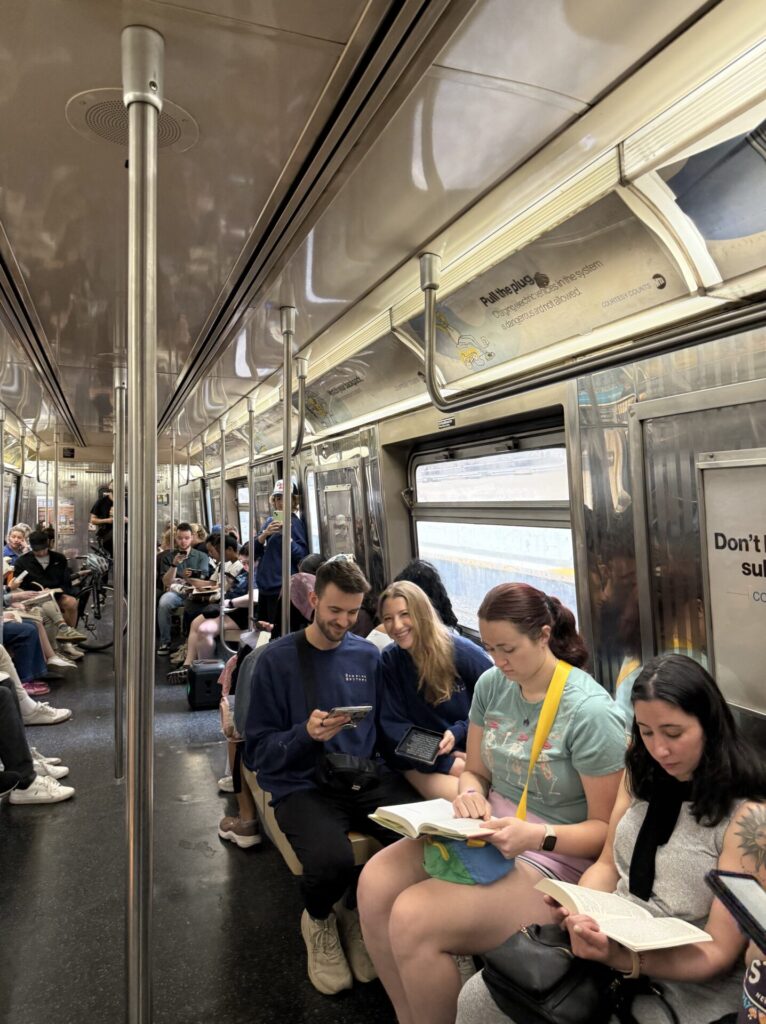“Disrupting Isolation,” as Dennis Uhlman put it in this very publication, requires innovative and unorthodox thinking.
In our age of loneliness and social atomization we have, albeit tacitly, accepted a paradigm that Emile Durkheim termed anomie. That is, a sort of uprootedness and lack of belonging.
This is born out in various facets of our lives and shows up in many studies and polls, including in a new NBC News Poll. The poll, perhaps unsurprisingly, finds that “twenty-nine percent of U.S. adults under age 30 say they feel lonely or isolated from those around them all of the time or most of the time.”
Americans—especially Millennials and Zoomers, who are faced with the arduous task of patching a frayed social fabric—must find their footing and escape this doom-loop of loneliness and civic disengagement.
To do that will take some serious effort. Some propose government policies and grand plans. Others, however, just do something about it.
One group, Reading Rhythms, founded in 2023, is bringing people together through the power of reading. After seeing that the barrier to entry was rather low—just $20 and a book of your choosing—I figured I’d go and see what the buzz was about.
Though admittedly dubious at first (how, I thought, could reading, a decisively solitary activity, bring about social connection?), I was delightfully surprised by what I found: an enthusiastic bunch of young people, books in hand, ready to meet new friends.
The format is simple: We start with 30 minutes of independent reading time, followed by an increment of 1-on-1 or 2-on-1 conversation about what we’re reading, then another silent reading session, ending with group discussion. Great facilitators and prompts around the room—which, in this case, was an unassuming brewery with ample seating and verdant plant displays—helped keep conversation on track. The addition of some ambient music—which tenor guitar player John Lawlor once described as “musical wallpaper”—was a nice touch, too.
Though some folks were understandably timid at first, a wave of loquacity hit the room during our conversation time; everyone wanted to discuss what they had been reading. I even saw some people exchanging phone numbers and inquiring about the next event.
Impressed by this unusual way of cultivating community in a city—NYC, that is—known for its “alone together” anonymity, I decided to reach out to one of the Prospect Heights Reading Rhythms chapter leads, Leita Williams, for a brief conversation.
“People go to these events because they want to be seen,” Williams told me, “and because they want to meet people who they can connect with in the outside world.”
In an age when a growing number of people feel as though they simply don’t belong—in their homes, places of work, and elsewhere—this feeling of “being seen” is particularly important.
“People have told us,” Williams continued, “that they are feeling lonely, and that they are looking to feel connected to a community.” There’s no question that the feeling of community is robust at Reading Rhythm events.
Just last month, on World Book Day, Williams planned a Reading Rhythms event at an unlikely venue: the NYC subway.
Just last month, on World Book Day, Williams planned a Reading Rhythms event at an unlikely venue: the NYC subway.
Tommy Heller, author of the group’s newsletter, writes:
On a crisp, lively day, we boarded the subway at 96th Street with books in hand, heading all the way to Coney Island. And let us tell you, the public wasn’t quite ready for the reading magic that hit that train. The energy was electric as strangers turned into fellow readers, all diving into their books during quiet reading periods, exchanging ideas during 1-on-1 breakouts, and engaging in group discussions that brought out the best of literary themes.
This is a welcomed respite from today’s always-online culture. “I get so tired of just looking around on the train and seeing every single person with their eyes on their phone, it drives me crazy!” Williams told me. “I try to shake up the subway in my day-to-day life by striking up conversations with other readers on the train. If I see someone sitting next to me with a book, I’ll say, ‘hey, book club!’”
To create an event on this large a scale, though, was a much more challenging undertaking. Williams, however, determined to disrupt isolation head-on, was able to plan something truly remarkable.
To change today’s “me-centric” ethos will require us to step outside of our comfort zones and go to events like the ones Reading Rhythms are hosting. It may feel unnatural at first, but these are the kinds of actions we can take right now to transform isolation into community.
Image via Flickr








2 comments
Immigration Helps
What struck me most was how intentional the group’s efforts are—not just encouraging people to read, but creating physical spaces where conversation, reflection, and shared humanity can unfold organically. There’s something deeply grounding about gathering around a story, especially one that prompts empathy or sparks memories. In that context, reading becomes more than a solitary act; it’s a bridge.
The article also highlights how this initiative offers a gentle alternative to more tech-driven or commercialized attempts at “community.” There’s no app, no metrics to track, just people showing up with a book and a willingness to listen. That simplicity feels radical in its own way. It reminds us that real connection often comes from slowing down, being present, and sharing ideas face-to-face.
user-401407
awesome
Comments are closed.